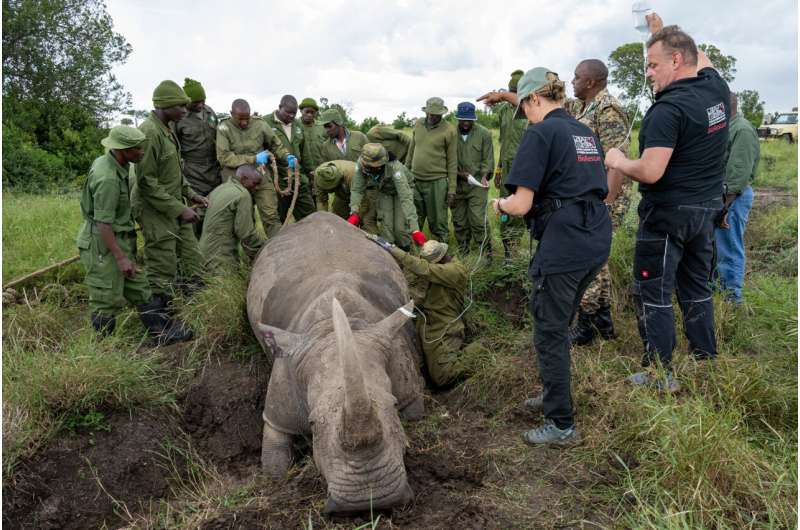Southern white rhino female for the BioRescue project. Credit: Jon A. Juarez
In the four years since the start of an ambitious project to save the northern white rhino from extinction, the BioRescue consortium has made significant progress towards its ultimate aim. Using advanced assisted reproduction technologies, 29 northern white rhino embryos have been created and cryopreserved, ready for a future transfer to a surrogate mother.
During a scientific field trip to Kenya in May 2023, the thirteenth egg collection from a northern white rhinoceros (NWR) was carried out by a team of scientists and conservationists from the Leibniz Institute for Zoo and Wildlife Research (Leibniz-IZW), Ol Pejeta Conservancy, Safari Park Dvůr Králové, Kenya Wildlife Service (KWS) and Wildlife Research and Training Institute (WRTI) at Ol Pejeta Conservancy in Kenya.
The procedure involving female rhino Fatu went smoothly without any complications, and 18 eggs were harvested. They were matured and fertilized at the Avantea lab in Cremona, Italy, leading to five further embryos being produced, the highest number of embryos from any one egg collection so far. The sperm for fertilization came from two different bulls, thereby improving genetic diversity.
Previous procedures in November 2022 (eleventh collection) and February 2023 (twelfth collection) had yielded two and zero embryos, respectively.
Furthermore, in May 2023 the BioRescue team made another promising step toward saving the most endangered mammal species on our planet. The consortium members successfully identified and selected two wild southern white rhino females (SWR) as potential surrogate mothers. Both females were examined and translocated into a safe enclosure. They will now be crucial in supporting the breeding efforts within the BioRescue project for the NWRs.
The consortium members also checked the health status of the SWR teaser bull Ouwan and confirmed that he is still functionally sterilized. The teaser bull indicates by copulating with a female that a potential SWR surrogate mother is ready to receive an embryo. The bull must be sterilized; otherwise it makes no sense to perform an embryo transfer, as the female would become pregnant with the bull's sperm.
The next steps of the BioRescue project will be to perform embryo transfers with SWR embryos to demonstrate that the chosen transfer protocol is suitable and works. Once a proven pregnancy is achieved the team will use the protocol for transferring cryopreserved NWR embryos to produce viable offspring as soon as possible.
Provided by Leibniz-Institut für Zoo- und Wildtierforschung (IZW) im Forschungsverbund Berlin e.V.
























